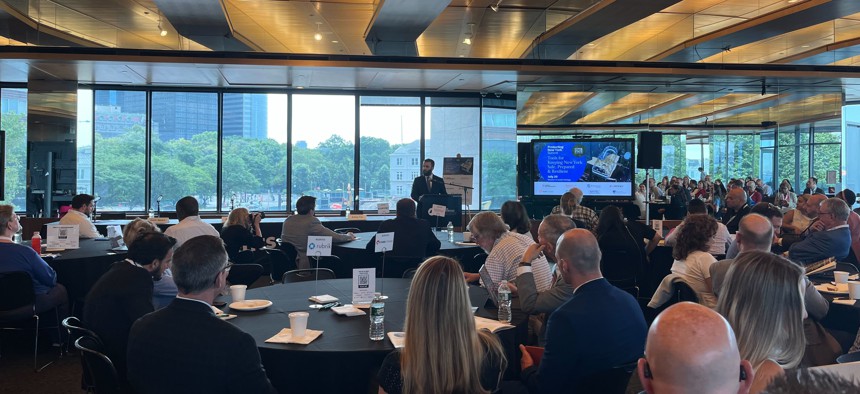Policy
Seeking public safety and cybersecurity solutions to protect New York
Experts at City & State’s 2023 Protecting New York summit pushed for collaboration and preventive measures to strengthen the state’s safety

Attendees at City & State’s 2023 Protecting New York summit at the Museum of Jewish Heritage in Lower Manhattan Thursday listen as state Chief Cyber Officer Colin Ahern delivers the keynote speech at the event. Amanda Salazar
Collaboration and preventative measures are the key to protecting New York from threats, both on-the-ground and digitally, public safety and cybersecurity experts said at an event about keeping New York safe.
Industry professionals, governmental workers and political staffers who work on public safety and cybersecurity gathered on Thursday at City & State’s “2023 Protecting New York: Tools for Keeping New York Safe, Prepared & Resilient” summit at the Museum of Jewish Heritage to discuss ways the state is working to improve safety.
“This all means that it requires a team of teams to build this state’s cyber posture and resilience, and why New York is best protected when we work together,” New York State Chief Cyber Officer Colin Ahern, the keynote speaker, said.
Though Ahern was just one of many security leaders who spoke at the event, all of the speakers highlighted the importance of partnership and connectivity between public agencies and private companies in the efforts to reduce crime, traffic violence and cyber threats. He noted that, just on the topic of cybersecurity alone at the state level, there are the Division of Homeland Security and Emergency Services, Office of Counterterrorism, Cyber Incident Response Team, New York State Intelligence Center and several other agencies and departments that all work together.
“New York has long understood the value of intelligence, preparedness and collaboration in securing our interests and protecting New Yorkers,” Ahern said. “Cyber threats don’t just exist on a battlefield in a distant land – they’re right here in our energy grid, in our hospitals and in our homes. I firmly believe that we have the team, the tools and the determination to prevail, and together we will continue to build partnerships and extend beyond sectors and beyond borders.”
Beyond having public and private sector groups work together, another common idea was addressing crime at its root and preemptively putting systems in place to prevent and handle threats, rather than reacting once crime has been committed.
Improving access to social services, expanding access to housing, better mental health care and supporting at-risk youths are all ways to prevent crime in the long term, according to speakers from the Reimagining New York Safety Initiatives panel. Programs aimed at engaging young people from at-risk situations in their communities and getting them degrees and jobs can also help. Since many people commit crime out of need, such as stealing food or diapers, or due to untreated mental illnesses, improving quality of life can be a preventative measure.
“The conversation has shifted from a, ‘Lock ‘em up,’ to one of asking, ‘Why are these things happening?’” First Deputy Public Advocate Nick Smith said.
In addition to trying to prevent crime at a people level, the Protecting and Supporting New York’s Infrastructure panel discussed ways to improve the city’s infrastructure to be able to better catch crime before or while it happens. Some methods of this mentioned include expanding Wi-Fi within the subway so people can use their phones to report situations while en route – a reference to the city’s ‘see something, say something’ campaign – and using AI and cameras to be able to identify weapons on an individual’s person through a live feed.
“We’re working on, currently together with the [Metropolitan Transportation Authority], to extend the free public Wi-Fi and the cellular service that currently exists in the below-ground stations in the New York City subway to all of the tunnels that exist, so when you walk down those subway stations to time you walk up the stairs at the end, your phone is working and you can reach whoever you need to reach them the whole time,” Link Solutions President Robert Sokota said.

